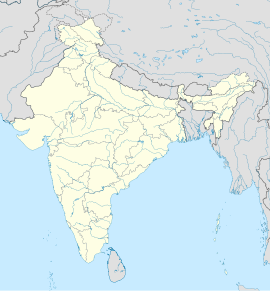Rangpur is an ancient archaeological site in Surendranagar district near Vanala on Saurashtra peninsula in Gujarat, western India. Lying on the tip between the Gulf of Khambhat and Gulf of Kutch, it belongs to the period of the Indus Valley civilization, and lies to the northwest of the larger site of Lothal.[1] It is the type site for the Rangpur culture, a regional form of the late phase of the Indus Valley Civilization that existed in Gujarat during the 2nd millennium BCE.
| Location | Surendranagar district, Gujarat, India |
|---|---|
| Coordinates | 22°26′N 71°55′E / 22.433°N 71.917°E |
| Type | Settlement |
| History | |
| Periods | Harappan 1 to Iron Age |
| Cultures | Indus Valley civilization |
Excavation
editRangpur culture: Based on the distinct pottery excavated here, it was identified as a separate culture or subculture.[2]
Trail Diggings were conducted by the Archeological Survey of India (ASI) during 1931 led by M.S.Vats. Later, Ghurye (1939), Dikshit (1947) and S. R. Rao (1953–56) excavated the site under ASI projects.[3]
S.R.Rao has classified the deposits into four periods with three sub periods in Harappan Culture, Period II with an earlier Period, Microlithic and a Middle Paleolithic State (River sections) with points, scrapers and blades of jasper. The dates given by S.R.Rao are:
- Period I - Microlithis unassociated with Pottery : 3000 BC
- Period II - Harappan : 2000–1500 BC
- Period II B - Late Harappan : 1500–1100 BC
- Period II C - Transition Phase of Harappa : 1100–1000 BC
- Period III - Lustrous Red Ware Period : 1000-800 BC.[3]
Architecture and town planning
editAcacia wood was used in Rangpur for construction, tools and furniture.[4]
Artifacts found
editDishes with beaded rim and grooved shoulder, painted black - and redware and high-necked jars.[5] Evidence of shell working found.[6] Other artifacts found at the site include axes, beads of steatite and carnelian and Earthen wares.
Cultivation
editLarge quantity of plant remains were found at Rangpur. Bajra,[7] rice[1] (Period IIA) and Millet (Period HI) were found.[8]
Diet
editPeople of Rangpur culture used rice and bajra for food. They also used to consume milk and curds from their domesticated animals.[9]
See also
edit- List of Indus Valley Civilization sites
- Periodisation of the Indus Valley Civilisation
- Ahar-Banas culture
- Late Harappan Phase of IVC (1900 - 1500 BCE)
- Cemetery H culture in Punjab
- Jhukar-Jhangar culture in Punjab
- Rangpur culture in Gujarat
References
edit- ^ a b History of Ancient and Early Medieval India, by Upinder Singh
- ^ The Harappan Civilisation: Its Sub-cultures, Daily Pioneer, 10 May 2018.
- ^ a b "Excavations - Important - Gujarat". asi.nic.in. Archived from the original on 12 December 2007. Retrieved 25 June 2020.
- ^ McIntosh, Jane.(2008) The Ancient Indus Valley : New Perspectives. ABC-CLIO. Page 140 [1]
- ^ Archeological Surve of India Publication: Indian Archeology 1955-56. Page 70 [2]
- ^ Singh, Upinder (2008). A history of ancient and early medieval India : from the Stone Age to the 12th century. New Delhi: Pearson Education. p. 164. ISBN 9788131711200.
- ^ McIntosh, Jane.(2008) The Ancient Indus Valley : New Perspectives. ABC-CLIO. Page 112 [3]
- ^ Bridget and Raymond Allchin (1968) The Rise of Civilisaton in India and Pakistan. Page 245 [4]
- ^ Prakash, Om (2005). Cultural History of India. New Age International. p. 450. ISBN 978-81-224-1587-2.
Further reading
edit- Shikaripur Ranganatha Rao; Braj Basi Lal (1960). Excavation at Rangpur and Other Explorations in Gujarat.
